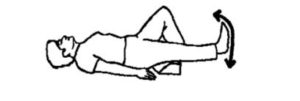Knee pain emergency department leaflet
Download and print as a PDF
DownloadOverview
You have been seen in the Emergency Department for knee pain and discharged home. This leaflet provides an overview of knee pain, how to treat it and exercises to help improve the movement of your knee joint.
The vast majority of knee pain settles without any intervention and requires no more treatment than pain relief.
Most patients require no intervention but occasionally you may be given a splint for your knee known as a cricket pad splint.
We rarely give crutches for knee pain as it prolongs the duration of your symptoms. If you cannot walk however we may need to give you crutches.
In some cases you may be referred for review in the Orthopaedic fracture clinic but that is unusual.
If your pain worsens, you find it harder to move the joint or there is increased warmth and swelling in the joint please seek prompt medical review.
Knee pain
Most knee pain is not due to a serious condition and will resolve with time.
The symptoms include
- Pain.
- Swelling.
- Stiffness.
- Bruising.
- Reduced movement.
- Muscle weakness.
- Tightness in the back of your thigh and calf.
Knee pain can be caused by a twist or a fall which may strain or sprain the ligaments, tendons or muscles. It may also be the result of overuse or repetitive strains such as running.
It is important to rest your knee but also to gently exercise it to avoid stiffness and prolonged discomfort.
Early, gentle movement of the knee will help it heal more quickly. Moving your knee will aid circulation and reduce pain, stiffness and swelling.
The initial pain usually settles within a few days.
The majority of simple strains do not cause lasting problems, as the body is very good at healing itself.
What treatments can I use?
Painkillers.
If your doctor has prescribed painkillers, they should be taken at the recommended dose.
Rest.
Try and rest the leg for the first 24-72 hours. However, it is important to maintain flexibility in the knee so gently move it without causing too much pain. This will help with the healing process.
Ice.
Wrap an ice pack (or a bag of frozen peas) in a damp towel and place over the knee. Use for 15 minutes up to three times a day. This will help reduce the swelling and pain.
Elevation.
Whilst resting, place the leg in an elevated position with a support under your knee, so that the ankle is higher than the hip, to reduce swelling.
Early movement and exercise.
Do not rest for long periods at a time as this will lead to stiffness and weakness and prolong your recovery.
Simple exercises can be performed to help gain full function of your knee.
Moving stiff muscles and joints is often uncomfortable to start with but becomes much easier as you regain the movement in your knee.
Exercises for your knee
1. Pull your toes up towards your head and push your knees firmly into the floor.

2. Slide your foot up and down the bed, gently moving the knee joint.

3. Put a cushion under the knee, pull your foot and toes up, tighten your thigh muscle and straighten the knee.

4. Stand with the leg to be stretched straight behind you and the other leg bent in front of you. Hold onto the wall and lean forwards and down until you feel the stretching in the calf of the straight leg.

Please note: these exercises should not increase your pain. Perform each exercise gently and slowly, only moving as far as feels comfortable. Practice each exercise up to 10 times. Do the exercises two or three times per day.
General support
For general medical advice please use the NHS website, the NHS 111 service, walk-in-centres, or your GP.
- The NHS website provides online health information and guidance.
- NHS 111 phone line offers medical help and advice from trained advisers supported by nurses and paramedics. Available 24 hours a day. Calls are free from landlines and mobile phones.
- There are walk-in and urgent treatment services at Brighton Station, in Crawley and at Lewes Victoria Hospital.
- Patient Advice and Liaison Service (PALS) can be contacted with your comments and concerns, and to provide general support.
This information is intended for patients receiving care in Brighton & Hove or Haywards Heath.
The information in this article is for guidance purposes only and is in no way intended to replace professional clinical advice by a qualified practitioner.
Publication Date: February 2019
Review Date: November 2022


